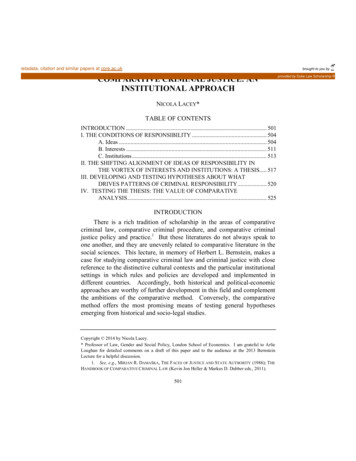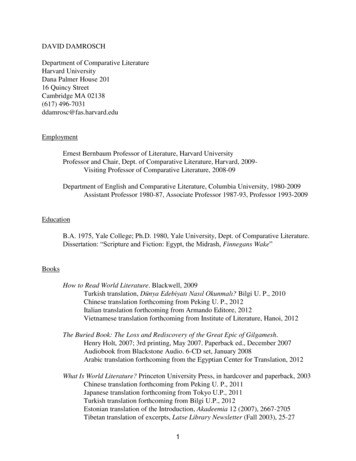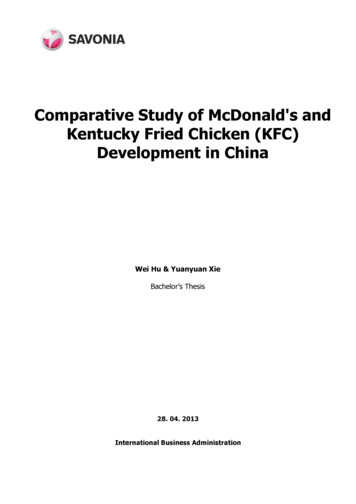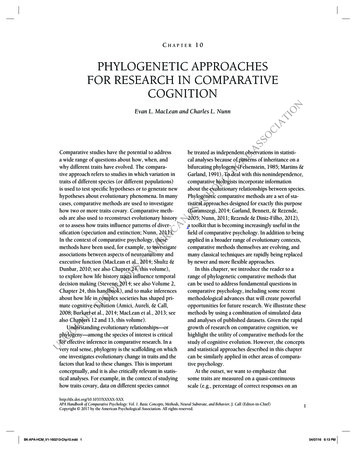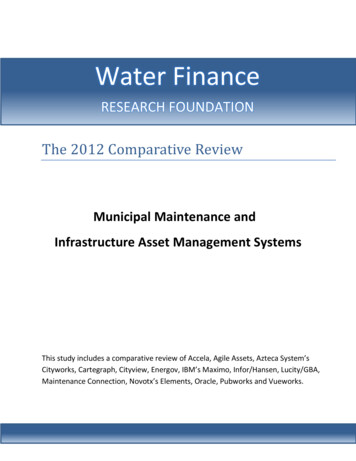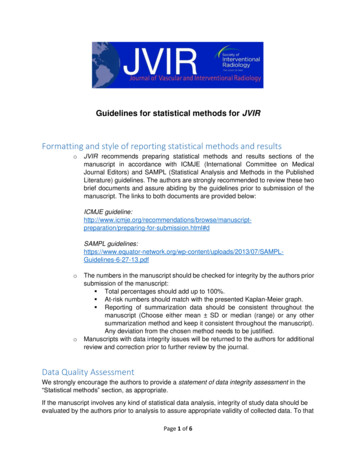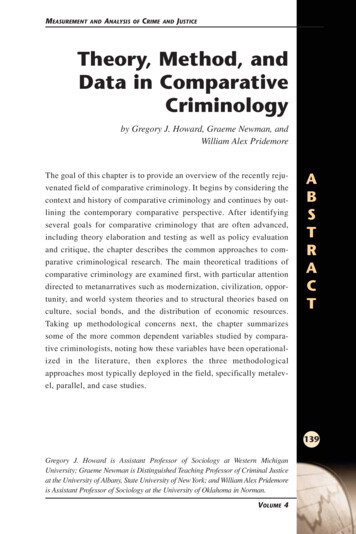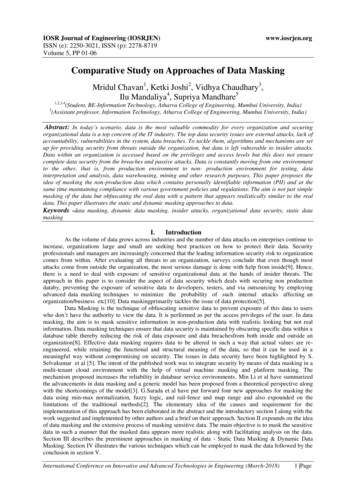
Transcription
IOSR Journal of Engineering (IOSRJEN)ISSN (e): 2250-3021, ISSN (p): 2278-8719Volume 5, PP 01-06www.iosrjen.orgComparative Study on Approaches of Data MaskingMridul Chavan1, Ketki Joshi2, Vidhya Chaudhary3,Ilu Mandaliya4, Supriya Mandhare51,2,3,45(Student, BE-Information Technology, Atharva College of Engineering, Mumbai University, India)(Assistant professor, Information Technology, Atharva College of Engineering, Mumbai University, India)Abstract: In today’s scenario, data is the most valuable commodity for every organization and securingorganizational data is a top concern of the IT industry. The top data security issues are external attacks, lack ofaccountability, vulnerabilities in the system, data breaches. To tackle them, algorithms and mechanisms are setup for providing security from threats outside the organization, but data is left vulnerable to insider attacks.Data within an organization is accessed based on the privileges and access levels but this does not ensurecomplete data security from the breaches and passive attacks. Data is constantly moving from one environmentto the other, that is, from production environment to non- production environment for testing, datainterpretation and analysis, data warehousing, mining and other research purposes. This paper proposes theidea of masking the non-production data which contains personally identifiable information (PII) and at thesame time maintaining compliance with various government policies and regulations. The aim is not just simplemasking of the data but obfuscating the real data with a pattern that appears realistically similar to the realdata. This paper illustrates the static and dynamic masking approaches to data.Keywords -data masking, dynamic data masking, insider attacks, organizational data security, static datamaskingI.IntroductionAs the volume of data grows across industries and the number of data attacks on enterprises continue toincrease, organizations large and small are seeking best practices on how to protect their data. Securityprofessionals and managers are increasingly concerned that the leading information security risk to organizationcomes from within. After evaluating all threats to an organization, surveys conclude that even though mostattacks come from outside the organization, the most serious damage is done with help from inside[9]. Hence,there is a need to deal with exposure of sensitive organizational data at the hands of insider threats. Theapproach in this paper is to consider the aspect of data security which deals with securing non productiondataby, preventing the exposure of sensitive data to developers, testers, and via outsourcing by employingadvanced data masking techniques to minimize the probability of such internal attacks affecting anorganization/business etc[10]. Data maskingprimarily tackles the issue of data protection[5].Data Masking is the technique of obfuscating sensitive data to prevent exposure of this data to userswho don’t have the authority to view the data. It is performed as per the access privileges of the user. In datamasking, the aim is to mask sensitive information in non-production data with realistic looking but not realinformation. Data masking techniques ensure that data security is maintained by obscuring specific data within adatabase table thereby reducing the risk of data exposure and data breachesfrom both inside and outside anorganization[8]. Effective data masking requires data to be altered in such a way that actual values are reengineered, while retaining the functional and structural meaning of the data, so that it can be used in ameaningful way without compromising on security. The issues in data security have been highlighted by S.Selvakumar et al [5]. The intent of the published work was to integrate security by means of data masking in amulti-tenant cloud environment with the help of virtual machine masking and platform masking. Themechanism proposed increases the reliability in database service environments. Min Li et al have summarizedthe advancements in data masking and a generic model has been proposed from a theoretical perspective alongwith the shortcomings of the model[3]. G.Sarada et al have put forward four new approaches for masking thedata using min-max normalization, fuzzy logic, and rail-fence and map range and also expounded on thelimitations of the traditional methods[2]. The elementary idea of the causes and requirement for theimplementation of this approach has been elaborated in the abstract and the introductory section I along with thework suggested and implemented by other authors and a brief on their approach. Section II expounds on the ideaof data masking and the extensive process of masking sensitive data. The main objective is to mask the sensitivedata in such a manner that the masked data appears more realistic along with facilitating analysis on the data.Section III describes the preeminent approaches in masking of data - Static Data Masking & Dynamic DataMasking. Section IV illustrates the various techniques which can be employed to mask the data followed by theconclusion in section V.International Conference on Innovative and Advanced Technologies in Engineering (March-2018)1 Page
Comparative Study On Approaches Of Data MaskingII.Data MaskingOrganizations share the data from production environment for various business needs[11]. Somenterprises do not do much to protect their data in non-production environments. Hence, the data maskingtechniques are employed to safeguard sensitive data in non-production environments.Data Masking is an approach in which the sensitive production data which is obtained from liveapplications, is obfuscated into realistic looking fake data for non-production activities such as testing, qualityassurance, development etc. The general process of how data masking takes place is given in Fig. 1 as follows:Fig. 1: The process of data maskingA comprehensive 4-step approachfor implementing data masking consists of the following steps[1,4]:1.Detect sensitive dataTo initiate the process of data masking, the data that needs to be masked must be identified. Thedecision on what constitutes as sensitive data is made by taking into consideration various governmentregulations and policies that dictate how sensitive data can be used or shared. This phase identifies sensitive orregulated data across the entire organization. The purpose is to come up with the list of sensitive data elementsspecific to the organization and discover the associated tables, columns and relationships across databases thatcontain the sensitive data. This is carried out usually by data, security and business analysts. Upon completionof this step, the next phase is the assessment of data.2.Assess dataThis step oversees the location of sensitive data in the organization schema/database. The DBA canthen designate an attribute/column as sensitive for inclusion in the masking process or not sensitive forexclusion from future ad hoc pattern searches. Hence, identification of the masking algorithms to replace theoriginal sensitive data. Developers or DBAs work with business or security analysts with their own maskingroutines.3.Mask dataOnce the detection and analysis of sensitive data in non-production environments is performed, theDBA can execute the masking algorithms decided in the previous phase to replace/mask all the sensitive data.This is the iterative phase.4.TestThe final step of the masking process is to test whether the mask has been correctly defined andcreated. Once the masking process has completed and has been verified, the DBA then hands over theenvironment to the application testers. If the masking algorithms need further changes, then the DBA restoresthe database to the pre-masked state, makes the necessary adjustments to the masking algorithms and reexecutes the masking process.III.Approaches To Data MaskingData Masking has two basic approaches namely static data masking and dynamic data masking[7]. Thefundamental difference between the two is that, in static data masking the sensitive data is permanently maskedby altering data at rest whereas in dynamic data masking, the sensitive data is masked in transit which leaves theoriginal data intact and unaltered.1.1 Static Data MaskingStatic data masking mask the sensitive data in the production databaseby the use of pre-decidedmasking techniques[10]. It provides a basic level of data protection as it creates an offline version of the liveproduction database. Generally organizations and enterprises employ static data masking when they want tocontract out their data to third party or developers etc. Hence, realistic looking data can be used for testing,quality assurance and development without disclosing sensitive information.Additional applications encompasses safeguarding sensitive data for benefit in analytics and trainingcompliance with standards and regulations (GDPR, PCI, HIPAA) that impose limits on how organizations makeuse of data, especially PII[11].International Conference on Innovative and Advanced Technologies in Engineering (March-2018)2 Page
Comparative Study On Approaches Of Data MaskingFig. 2: Conceptual diagram of Static Data MaskingAs shown in Fig. 2, in static data masking, the live production database is duplicated and an offlinecopy (Golden Masked Copy) constructed with all the sensitive fields masked. Hence, inherently there are twodatabases which are ordinarily not synchronized. The golden masked copy commonly lags behind the liveproduction database, but it is updated on a periodic basis. The impediment of static data masking is that theactual live production database is left unprotected, so personnel who do have access to it can view the actualdatarecords and not masked records. Finally, the overhead incurred by having two copies is significant as it includesthe cost of maintenance and hardware.1.2 Dynamic Data MaskingIn dynamic data masking,the sensitive data is masked in transit which leaves the original data intactand unaltered[7]. Data is obfuscated as it is accessedin real time and the sensitive data never leaves the liveproduction database. Dynamic data masking is also used as tool to enforce role-based security in applications.3.2.1 Request Based Dynamic Data MaskingFig. 3: Conceptual diagram of Request Based Dynamic Data MaskingAs shown in Fig. 3, in request based dynamic data masking, the query sent by the user is reconstructedwith the masking actions before it is sent to the database in real time. The database then receives the query withthe masking applications to be performed.3.2.2 Response Based Dynamic Data MaskingFig. 4: Conceptual diagram of Response Based Dynamic Data MaskingAs shown in Fig. 4, in response based dynamic data masking, the query is sent to the database in realtime and data is masked in real time as it is received from the users.A considerable advantage of dynamic data masking is that there are no copies of the production dataand the sensitive data is masked from the live database itself. Since,the activities are performed on real data,timeis substantially saved.Most enterprises should employ both approaches of data masking, static data masking and dynamicdata masking to ensure data protection. Even with the static data masking in place, almost any organization withInternational Conference on Innovative and Advanced Technologies in Engineering (March-2018)3 Page
Comparative Study On Approaches Of Data Maskingsensitive data in live database should make use of dynamic data masking to protect live production systems.Static data masking is used for outsourcing and dynamic data masking to protect in premises live databases.Fig. 4: Applications of Data MaskingIV.Data Masking TechniquesDepending upon how sensitive the data is and the requirements of masking, data masking techniquesare implemented. Traditionally, several techniquesused for masking include substitution, shuffling, encryption,masking out, etc[1]. The limitation in using these techniques is that it fails in successful generation of randomvalues that are unique for every original value[2]. For reducing these limitations, techniques as follows can beimplemented and applied for unique masking.4.1. Fuzzy Based Approach:In this approach, the concept of fuzzy set theory is used, that generates a fuzzy logic output that can beused as a masked result. This approach is more likely to maintain the interrelation in the data and protectprivacy. A fuzzy membership function is used to map the data into a masking result, thus reducing the time toprocess. Using this approach, the data can only be masked within a range of 0-1. An example using S-shapedfuzzy functionis given below[6]:0,𝑥 𝑎𝑓 𝑥; 𝑎, 𝑏 2x a 𝟐b a1 2,𝑎 𝑥 𝑥 𝑏 2𝑏 𝑎𝑎 𝑏,21,𝑎 𝑏2 . (1) 𝑥 𝑏𝑥 𝑏Table 1: Specifications of the equation 1No.1.2.3.VariablesxabSpecificationsValue of sensitive attributeMinimum value in sensitive attributesMaximum value in sensitive attributesFig. 5: Example of Fuzzy Based ApproachInternational Conference on Innovative and Advanced Technologies in Engineering (March-2018)4 Page
Comparative Study On Approaches Of Data Masking4.2. Rail-fence Method:This technique is mostly applied to categorical data wherein the original data is written row/columnwise and the transformed data is fetched by traversing along columns/rowsrespectively[2]. An example ofmasking using this approach is given below:Fig. 6: Example of Rail-Fence Method4.3. Map Range (Rosetta Code):This method is of use when original data is needed to be mapped to a specified range. This method is mostlyused for mapping large numbers to small numbers. The formulais given as follows[2]:𝑡 𝑏1 (𝑠 𝑎1) 𝑏2 𝑏1(𝑎2 𝑎1) (2)Table 2: Specifications of the equation lue of sensitive attributeminimum value in sensitive attributesmaximum value in sensitive attributesmapped value of sensitive attributeminimum value in mapped rangemaximum value in mapped rangeFig. 6: Example of Map Range Method4.4. Masking Outs:This is a techniquethat simply masks some part of the original data with a specific character[2]. Thiscan be used when masking the data would not affect the regular processing, otherwise it is of no use when theoriginal data holds required information. An example is given below:International Conference on Innovative and Advanced Technologies in Engineering (March-2018)5 Page
Comparative Study On Approaches Of Data MaskingFig. 7: Example of Masking OutV.ConclusionA comparative study between the two fundamental approaches of data masking, namely static datamasking and dynamic data masking was performed and reviewed in this paper. The primary difference betweenthe two is that in static data masking, there is an offline copy of the live production database, called the testdatabase which has all of the sensitive data masked whereas in dynamic data masking, the live database is intactand unaltered and the masking is performed as and when the sensitive data is accessed i.e. Data is masked intransit. Enterprises need to employ both of these approaches to safeguard their data. Static data masking ispreferable in cases where data is outsourced – testing, development, data analysis etc. Dynamic data masking isemployed to protect the organizational data on premises and is used to fulfill the various government policies(GDPR, PCI, HIPAA) pertaining to the usage of sensitive data. The new masking techniques proposed- fuzzybased approach, rail fence method, etc. will prove advantageous over traditional methods of substitution,shuffling as they create data which is realistic looking but fake as opposed to just obfuscating the data whichmakes it pretty evident that the data is masked. These new techniques would also allow for robust nonproduction activities to be carried out onmasked data thereby safeguarding sensitive information from 9][10][11]Data Masking Best Practice, Oracle White Paper, June 2013.G Sarada, G Manikandan, Dr.N. Sairam,“A Few New Approaches to Data Masking”, International Conference on Circuit ,Power and Computing Technology 2015.Min Li, Zheli Liu, ChunfuJia ,Zongqing Dong, “Data Masking Generic Model”,Fourth International Conference on EmergingIntelligent Data and Web Technologies 2013.Osama Ali and AbdelkaderOuda, “A Classification Module in Data Masking Framework for Business Intelligence Platform inHealthcare”, IEEE, 2016.S.Selvakumar and M. Mohanapriya, "Securing Cloud Data in Transit using Data Masking Technique in Cloud EnabledMulti-Tenant Software Service", Indian Journal of Science and Technology, vol. 9, no. 20, 2016.Timothy J. Ross “Fuzzy Logic with Engineering Applications”, McGraw Hill International Editions, ipaa-softwareInternational Conference on Innovative and Advanced Technologies in Engineering (March-2018)6 Page
The general process of how data masking takes place is given in Fig. 1 as follows: Fig. 1: The process of data masking A comprehensive 4-step approachfor implementing data masking consists of the following steps[1,4]: 1. Detect sensitive data To initiate the process of data masking, the data that needs to be masked must be identified. The
